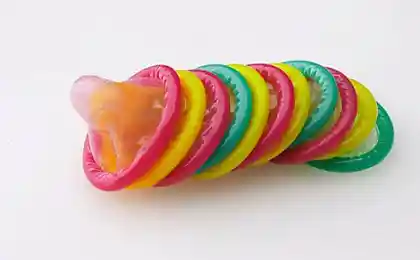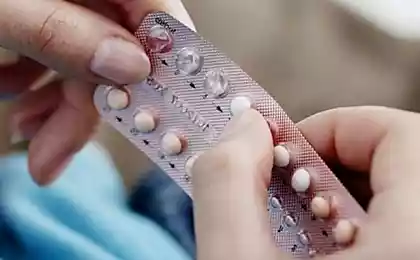807
The most unusual methods of contraception (10 photos)
Ten of the most questionable of contraceptive methods in the history of mankind.
1. Litter crocodiles

In ancient Egyptian documents relating to 1850 BC, can be found the description of a pessary - objects or mixtures introduced into the vagina to block sperm from entering the uterus. They are made from crocodile dung, honey and soda ash were widespread methods of contraception. Crocodile dung, in fact, contains some alkali as modern spermicides, so that such means could well be functional. 2. weasel testicles

In medieval culture were surprisingly inventive methods of birth control, one of which was tying testicles fondling the inside of the thighs. According to the myth, if you take two testicles fondling, wrap them in a cloth and tied to the hip of a woman who also has a bone affection, she will not be able to conceive a child. Needless to say that this method be absolute nonsense.
3. Mercury

More dangerous methods of contraception practiced by Chinese women thousands of years ago and implies the use of lead and mercury inside. This is a dangerous potion used concubines in China to remain fruitless. These substances tend to cause kidney failure, brain damage, and of course, death.
4. Tea, brewed on the beaver testicles

This tool is traditionally used in Canada in the 16th century. Women who wish to remain childless, soaked dried beaver testicles in a concentrated solution of alcohol and then drinking the resulting infusion. The effectiveness of this method, there is no data.
5. Bowel animals

One of the oldest in the world of condoms was made from pig intestines. There are even instructions for its use, according to which, a condom is needed to soak in warm milk to make it more soft and elastic.
Some historians argue that the first illustration of a man wearing a condom during intercourse, was an illustration of the Cretan king Minos, son of Zeus and Europe, who lived around 3000 BC. According to legend, the curse has led to the fact that sperm Minos contained snakes and scorpions. To protect their sexual the Lady from these animals, Minos used the goat bladder as a condom. On the other illustrations of ancient Egypt, of which about 3,000 years old, apparently depicts a man's penis is wrapped something like a shell.
The oldest ever found condoms date back to 1642, and represent a shell from the flesh of animals, such as sausage casings. They were found in the castle Dudley (Dudley Castle) in England.
6. Water from the forge

According to Soragna (Soranus), a gynecologist from Greece, practiced in the second century AD, a woman who did not want to become pregnant should have a drink of water, which the blacksmith used to cool metal.
Despite the fact that so far it is unclear why someone believed in it, women volunteered to lead the factories to remain sterile, even during the First World War. This could lead to neurological problems, kidney failure, seizures, coma and even death.
7. The diaphragm of opium

Sumatran ancient women used the shell of the plant as diaphragms during sexual intercourse.
8. The tampon of acacia, dates and honey

One of the first recorded on papyrus recipes contraceptive drugs dates back to 1550 BC and was found in Egypt. The recipe describes a tampon made of raw cotton, soaked in a mixture of acacia, dates and honey.
Despite its primitiveness, the tampon acted because acacia ferments into lactic acid, and this ingredient is used in spermicides today.
9. Coca-Cola and other sodas

Douching with Coca-Cola has become part of the tradition of contraceptive during the period between the 1950s and 1960s, when other methods of contraception were available. The idea that Coca-Cola could be used as a spermicide, was the big sensation at the awards ceremony Ig Nobel Prize, held at Harvard University in October 2008. The experiment was conducted in the laboratory of contraception at Harvard Medical School (Harvard Medical School). Scientists Anderson (Anderson), Hill (Hill) and Umpper (Umpierre) mixed four different types of Coke with sperm in order to check whether it is true the idea that Coca-Cola can be used as a contraceptive.
During laboratory experiments, the researchers found that diet cola kill all sperm within one minute, but the recently announced Coca-Cola brand «New Coke» still floated 41 per cent of condoms. Anderson said the following in an interview for the magazine «New Scientist»: «It was believed that the carbonic acid in Coke killed sperm - and that means delivered directly to your applicator" shake and shoot ". However, other scientists failed to confirm these results in further experiments.
10. Lemon iris

Funnies that should be noted is that in the 1700s, lemons used as quite effective contraceptive. The shape of half a lemon served as a diaphragm, and the acid in the citrus kill sperm. However, lemon juice can damage the walls of the vagina, so lemons were the most sensible choice.
1. Litter crocodiles

In ancient Egyptian documents relating to 1850 BC, can be found the description of a pessary - objects or mixtures introduced into the vagina to block sperm from entering the uterus. They are made from crocodile dung, honey and soda ash were widespread methods of contraception. Crocodile dung, in fact, contains some alkali as modern spermicides, so that such means could well be functional. 2. weasel testicles

In medieval culture were surprisingly inventive methods of birth control, one of which was tying testicles fondling the inside of the thighs. According to the myth, if you take two testicles fondling, wrap them in a cloth and tied to the hip of a woman who also has a bone affection, she will not be able to conceive a child. Needless to say that this method be absolute nonsense.
3. Mercury

More dangerous methods of contraception practiced by Chinese women thousands of years ago and implies the use of lead and mercury inside. This is a dangerous potion used concubines in China to remain fruitless. These substances tend to cause kidney failure, brain damage, and of course, death.
4. Tea, brewed on the beaver testicles

This tool is traditionally used in Canada in the 16th century. Women who wish to remain childless, soaked dried beaver testicles in a concentrated solution of alcohol and then drinking the resulting infusion. The effectiveness of this method, there is no data.
5. Bowel animals

One of the oldest in the world of condoms was made from pig intestines. There are even instructions for its use, according to which, a condom is needed to soak in warm milk to make it more soft and elastic.
Some historians argue that the first illustration of a man wearing a condom during intercourse, was an illustration of the Cretan king Minos, son of Zeus and Europe, who lived around 3000 BC. According to legend, the curse has led to the fact that sperm Minos contained snakes and scorpions. To protect their sexual the Lady from these animals, Minos used the goat bladder as a condom. On the other illustrations of ancient Egypt, of which about 3,000 years old, apparently depicts a man's penis is wrapped something like a shell.
The oldest ever found condoms date back to 1642, and represent a shell from the flesh of animals, such as sausage casings. They were found in the castle Dudley (Dudley Castle) in England.
6. Water from the forge

According to Soragna (Soranus), a gynecologist from Greece, practiced in the second century AD, a woman who did not want to become pregnant should have a drink of water, which the blacksmith used to cool metal.
Despite the fact that so far it is unclear why someone believed in it, women volunteered to lead the factories to remain sterile, even during the First World War. This could lead to neurological problems, kidney failure, seizures, coma and even death.
7. The diaphragm of opium

Sumatran ancient women used the shell of the plant as diaphragms during sexual intercourse.
8. The tampon of acacia, dates and honey

One of the first recorded on papyrus recipes contraceptive drugs dates back to 1550 BC and was found in Egypt. The recipe describes a tampon made of raw cotton, soaked in a mixture of acacia, dates and honey.
Despite its primitiveness, the tampon acted because acacia ferments into lactic acid, and this ingredient is used in spermicides today.
9. Coca-Cola and other sodas

Douching with Coca-Cola has become part of the tradition of contraceptive during the period between the 1950s and 1960s, when other methods of contraception were available. The idea that Coca-Cola could be used as a spermicide, was the big sensation at the awards ceremony Ig Nobel Prize, held at Harvard University in October 2008. The experiment was conducted in the laboratory of contraception at Harvard Medical School (Harvard Medical School). Scientists Anderson (Anderson), Hill (Hill) and Umpper (Umpierre) mixed four different types of Coke with sperm in order to check whether it is true the idea that Coca-Cola can be used as a contraceptive.
During laboratory experiments, the researchers found that diet cola kill all sperm within one minute, but the recently announced Coca-Cola brand «New Coke» still floated 41 per cent of condoms. Anderson said the following in an interview for the magazine «New Scientist»: «It was believed that the carbonic acid in Coke killed sperm - and that means delivered directly to your applicator" shake and shoot ". However, other scientists failed to confirm these results in further experiments.
10. Lemon iris

Funnies that should be noted is that in the 1700s, lemons used as quite effective contraceptive. The shape of half a lemon served as a diaphragm, and the acid in the citrus kill sperm. However, lemon juice can damage the walls of the vagina, so lemons were the most sensible choice.























